香川県宇多津街の一棟貸しの宿「古街の家」や、徳島・祖谷の「篪庵(ちいおり)」などを手掛けた、東洋文化研究者のアレックス・カー(Alex Arthur Kerr)さんの交流イベントがありました。アレックスさんの目線で、宇多津の街を歩き、古街の家を紹介する様子を動画で紹介させていただきます。下記の動画をご覧ください。
An event featuring Alex Arthur Kerr, an Eastern culture researcher who has worked on projects such as ‘Co-machi-no-ie’ in Utazu, Kagawa, and ‘Chiiori’ in Iya, Tokushima, was held. During the event, Alex Kerr walked through the streets of Utazu, sharing his perspective on the town and introducing Co-machi-no-ie. Please check out the video below.
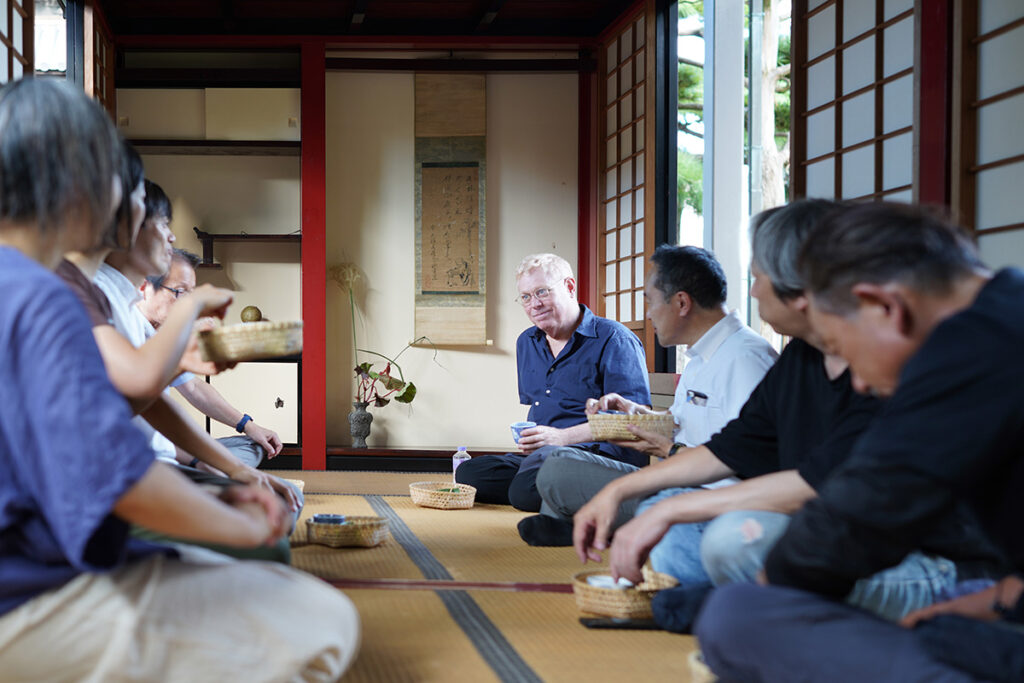
西光寺(さいこうじ)の船屋形茶室でお茶会が開かれました。江戸時代末期に多度津藩によって建造された茶室が移築されています。香川県指定文化財。 Saikoji Temple, Utazu, Kagawa – Funayakata Tea Room A tea ceremony was held at the Funayakata Tea Room in Saikoji Temple. The tearoom, originally built by the Tadotsu Clan at the end of the Edo period, has been relocated here. Designated as a cultural property of Kagawa Prefecture.
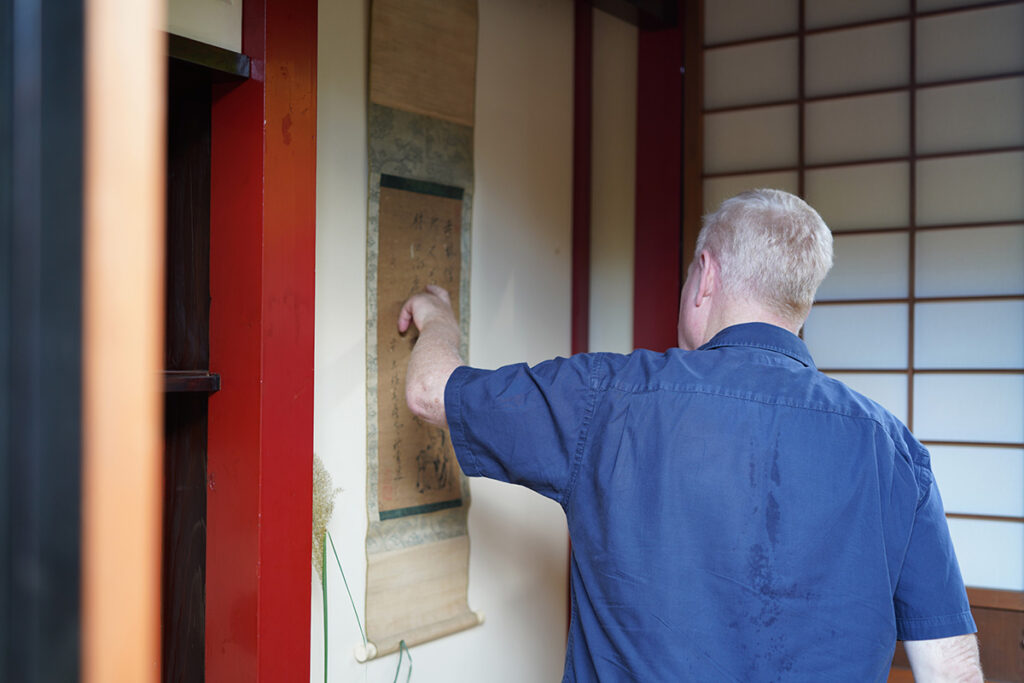
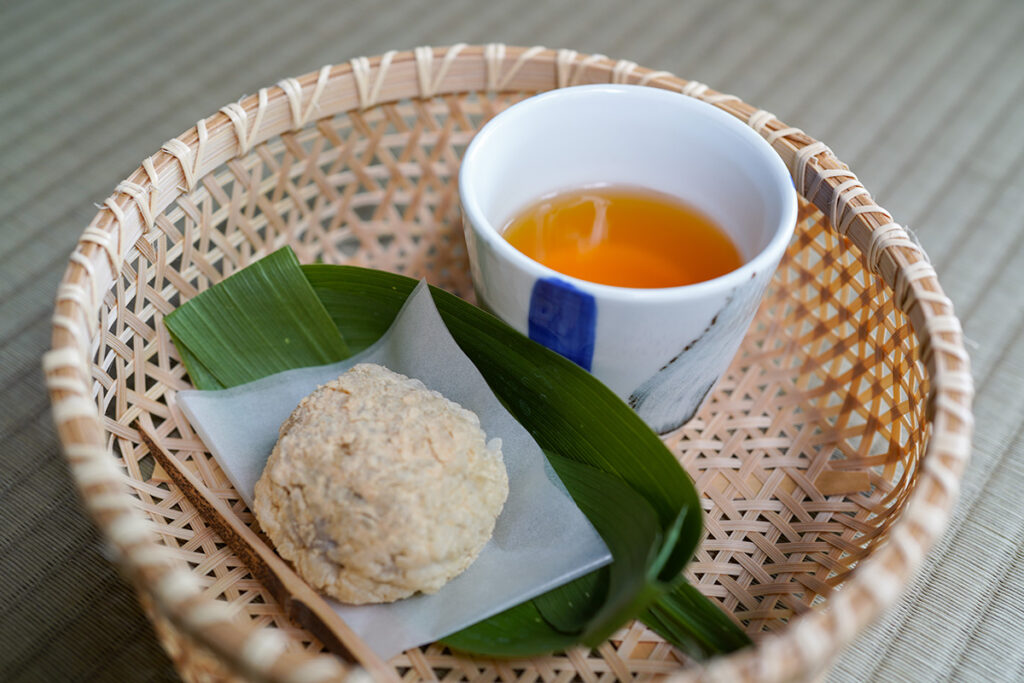
おはぎとお茶のおもてなし。 Hospitality with Ohagi and Tea.
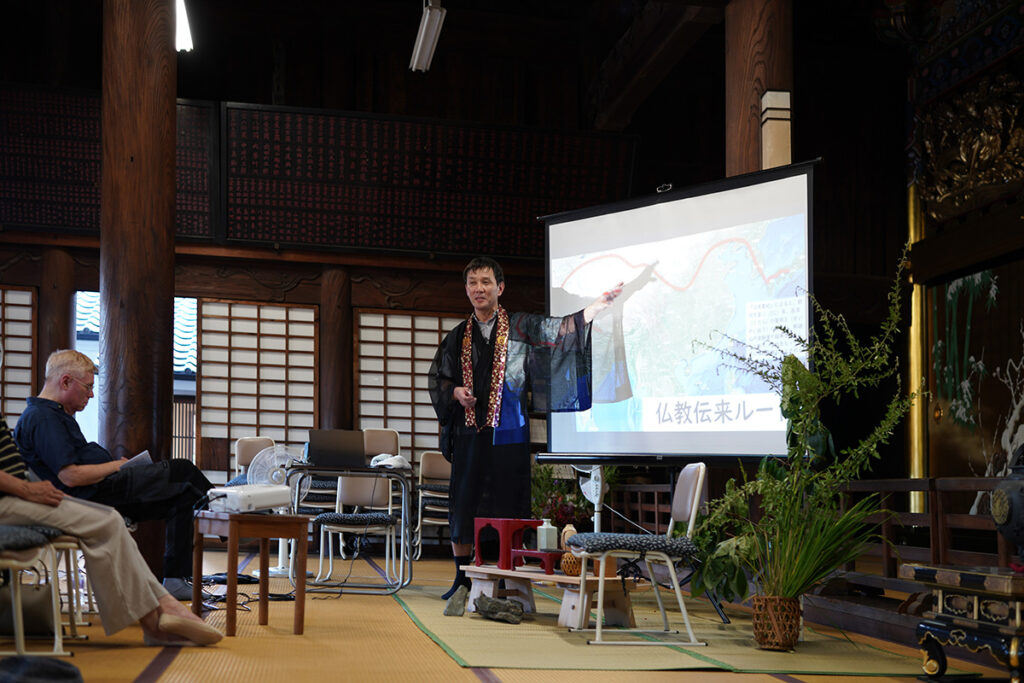
西光寺の住職に仏教伝来などのお話をしていただきました。 The head priest of Saikoji Temple gave a talk on the introduction of Buddhism and its history.
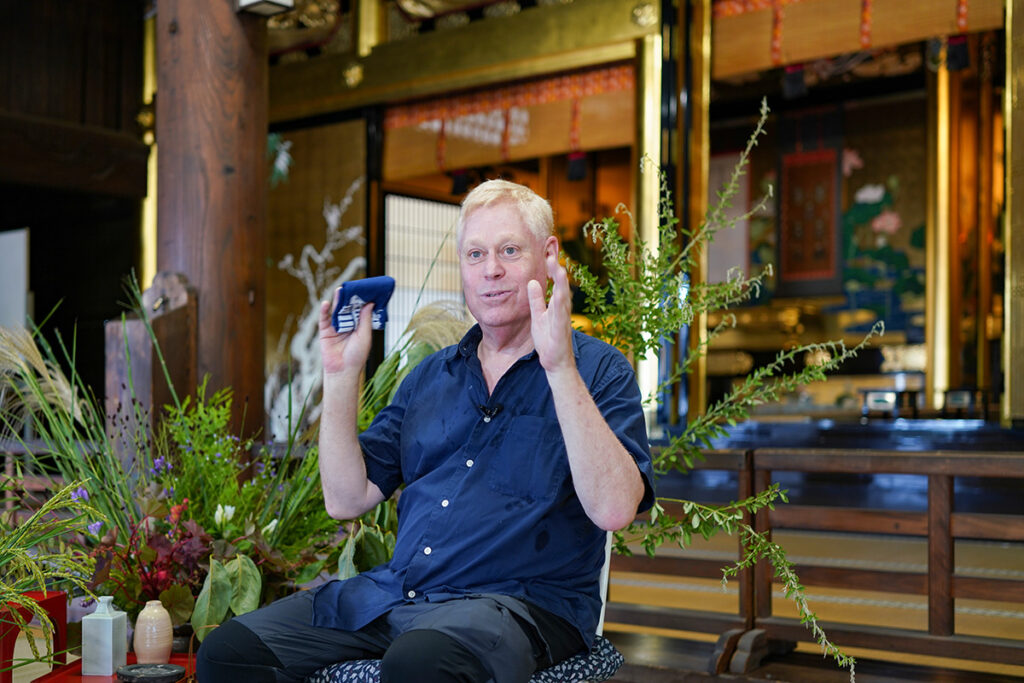
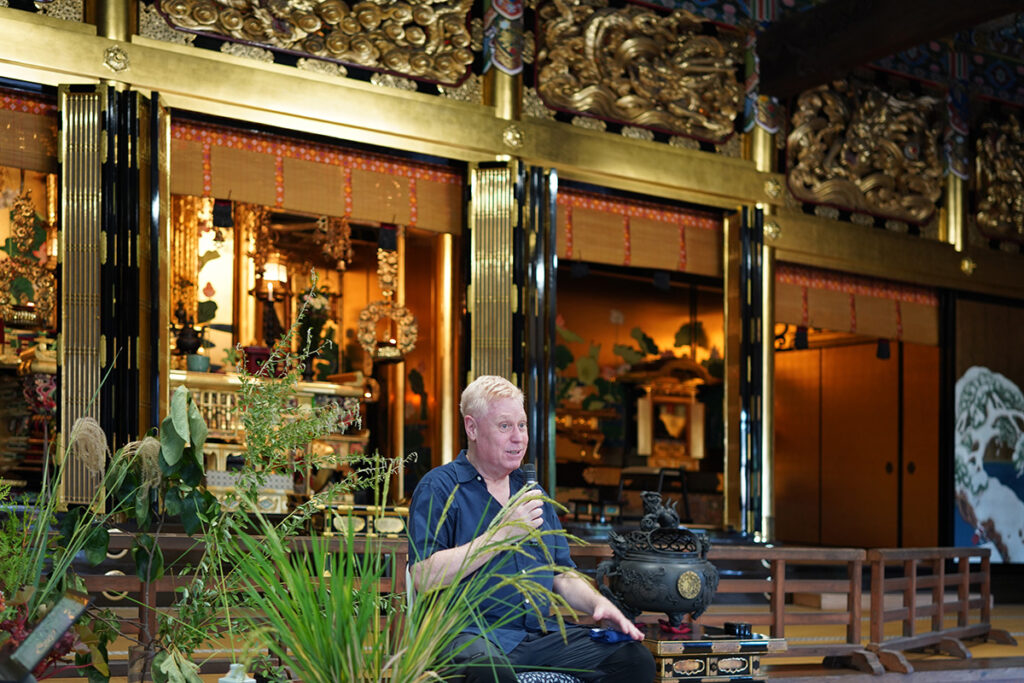
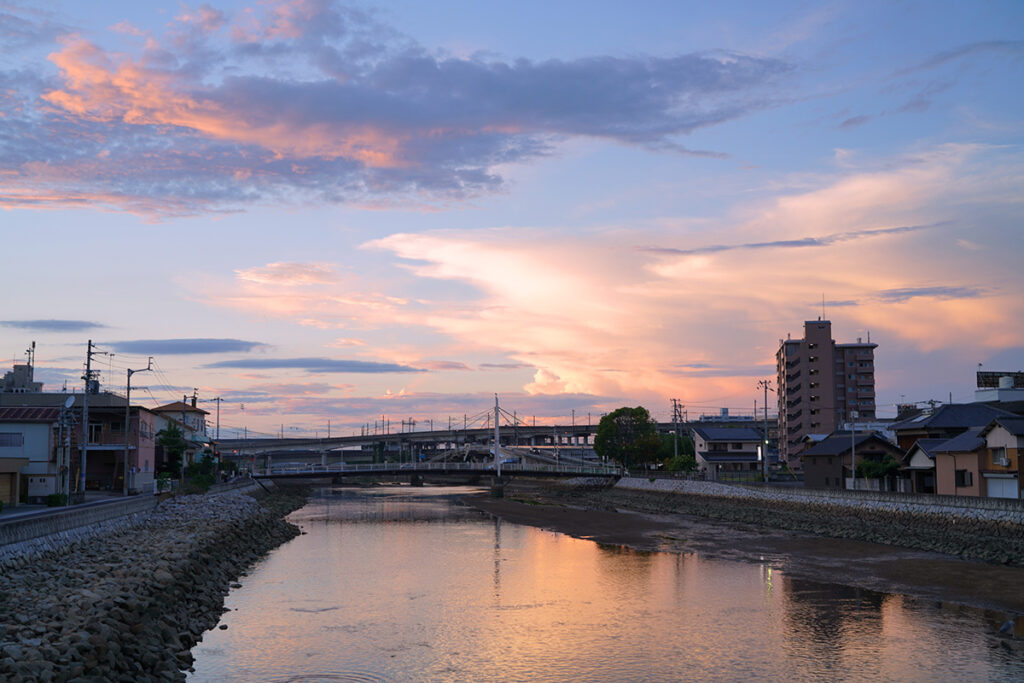
宇多津の古街は奇跡的に残ったわけです。生活のエリアと寺町、1つの界隈として残ったのは宇多津の街の魅力です。宇多津は海もあって古街もあって工場もあって、多様性のある街だと思いますね。
Co-machi of Utazu has miraculously survived. The coexistence of residential areas and the temple district as a single neighborhood is one of the charms of Utazu. Utazu has sea, Co-machi, and factories, making it a diverse city.
臨水(RINSUI):
臨水(りんすい)の方は、たばこ屋をやったり、お店だったんですよ。今は宿泊施設として中身が変わりました。「昔の街」としての良さを残しながら、現代の生活として変えていく、現代の人がハッピーにいられる気持ちよさ、今の時代の人たちのニーズに合わせることですね。「臨水」は非常に伝統的な雰囲気がありまして、お座敷を畳の間として残して、庭は日本庭らしく、土間も昔の土間の作り方として残しました。臨水でもう1つ好きなのが2階の屋根裏の寝室。昔の梁の雰囲気に戻して今の寝室になりました。
RINSUI
Rinsui used to be a tobacco shop and later became other types of stores. Now, it has been transformed into an inn. While preserving the charm of the ‘old town,’ it is about adapting it to modern life, creating an environment where people today can feel happy and comfortable, and meeting the needs of people in this era. ‘Rinsui’ has a traditional atmosphere, with tatami rooms remaining as they were, a Japanese-style garden, and the earthen floor preserved in the traditional way it used to be built. One more thing I love about Rinsui is the attic bedroom on the second floor. The bedroom was created by restoring the atmosphere of the old beams.
背山(SEZAN)
ハイカラな家だったんですね。それが「背山(せざん)」。ですから板の間にしました。日本的な庭にしないでウッドデッキ。この辺の欄間は非常に洒落ています。木の素材も面白いものを使ったり。棚のほうは、漆の付け方は工夫してきれいなものですね。
「山水」ですね。古い家が直ったら、僕は1つ「書」を書く、ラフな昔の部分と、洗練されたエレガントな部分は、特に古民家に必ず両方あるんですね。原始的なものに文明的なものをうまく組み合わせて。それはやっぱり面白い、美しい。日本の美の「エレガンス」「デリカシー」そのバランスでありながらアンバランスが究極な面白みだと思うんですね。
家に入って、家の声を聴く。どの家も同じということはないです。こうでありたいって家が言ってくれる。「花」もそう。ちょっと傾きたいんだよ。こうでありたいっていう思いがあるんだよ。
SEZAN
It was a stylish house. That’s ‘Sezan’. That is why we opted for a wooden floor. Instead of a traditional Japanese garden, we chose a wooden deck. This transom here is very swanky. We also used interesting types of wood materials. As for the shelves, the way the lacquer is applied is carefully crafted, and beautiful. This is ‘sansui(山水).’ When the old house is restored, I write one ‘calligraphy.’ The rough, traditional parts and the refined, elegant parts—these are both always present in an old house. Combining primitive elements with civilized ones. It is interesting, it is beautiful. The ultimate fascination lies in the balance of Japan’s beauty, with its ‘elegance’ and ‘delicacy,’ while also embracing an element of imbalance. Enter the house and listen to its voice. No two houses are the same. Each house tells you how it wants to be. So are flowers. They want to lean just a little. They have a desire to be in a certain way.
日本では、道端に生えている草や野生の生き物。必ずしも花が咲いているわけでもない、とても控えめなもの。そのような静かでシンプルな自然への愛が、日本の鍵なのだと思う。
In Japan, it was grasses, wild things that grow by the roadside. Very low key not necessarily even actually flowering. And that kind of love of quiet, simple nature, I think is key to Japan.
アレックス・カー
米国メリーランド州生まれ。1964年初来日。少年期に体験した日本の美しさと失われゆく現状を国内外に訴え、次代へ残すべく、文化芸術活動の推進、講演、執筆活動など幅広く行い、日本各地に残る美しい風景と文化を守り伝える事業を推進。東祖谷に残る古民家を再生、活用する新しいもてなしの形をプロデュース。著作に「美しき日本の残像」、「犬と鬼」などがある。
Alex Arthur Kerr
Born in Maryland, USA.
First visit to Japan in 1964. Having experienced the beauty of Japan during his youth and the current situation of its gradual loss, he advocates both domestically and internationally to preserve it for future generations. He actively promotes cultural and artistic activities, lectures, and writing, and leads initiatives to protect and pass down the beautiful landscapes and culture that remain across Japan. Produced a new form of hospitality by restoring and utilizing the old folk houses remaining in Higashi Iya. His works include ‘Lost Japan: Last Glimpse of Beautiful Japan’ and ‘Dogs and Demons: the Fall of Modern Japan.’